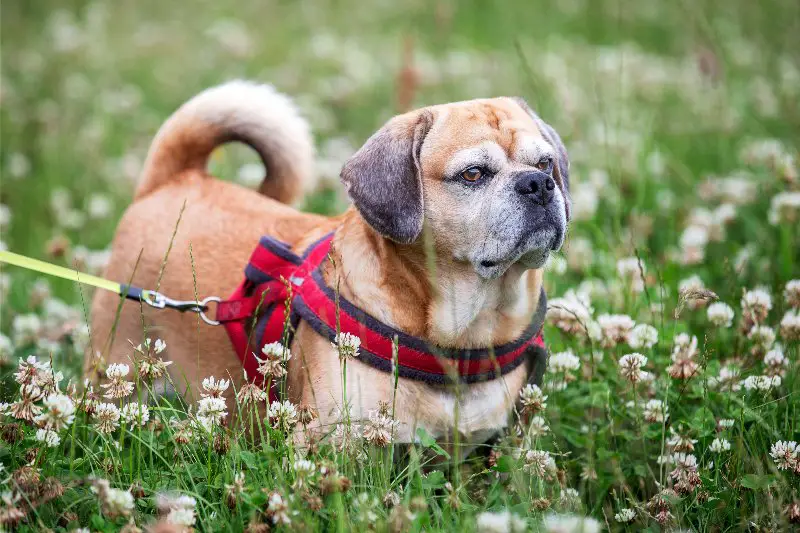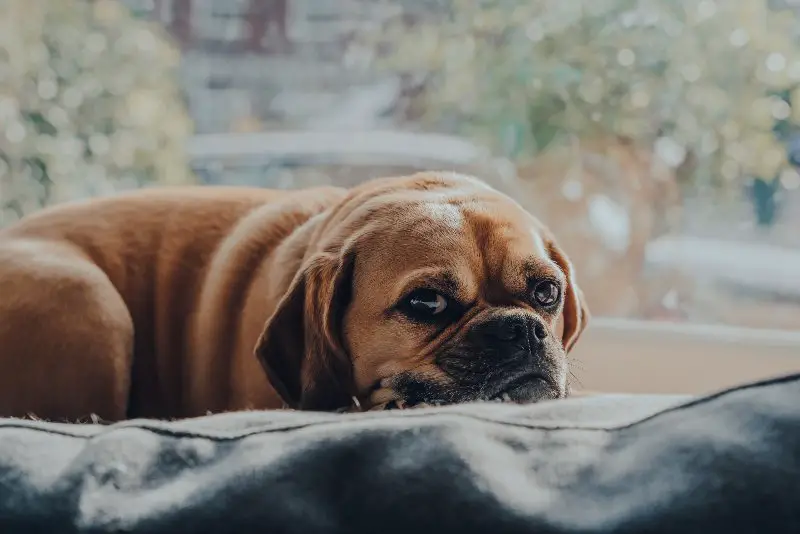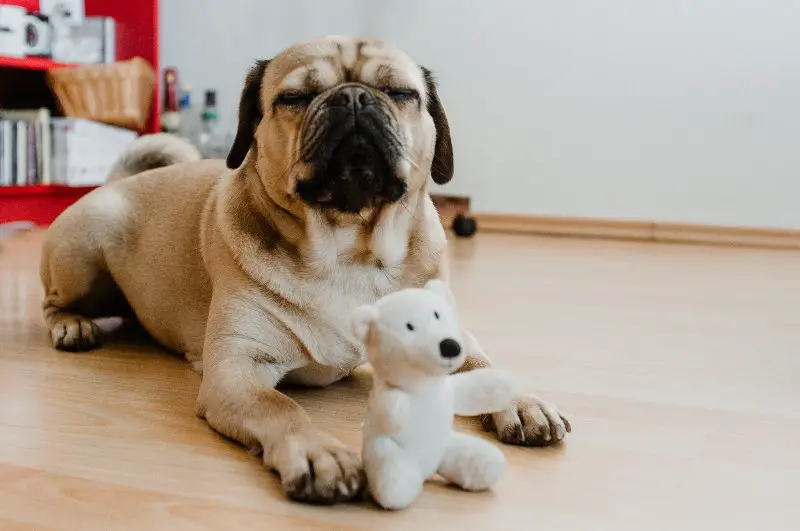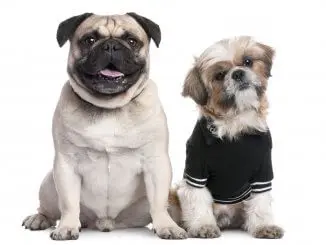
From Adobe Stock
My niece came to me with a sparkle in her eyes, clutching a picture of a dog she had fallen in love with. She didn’t know what breed it was, only that she hoped I could find one just like it for her birthday. The dog in the picture had a wrinkly face, a look of gentle curiosity, and a compact, sturdy body. I smiled, recognizing the breed immediately. “It’s a Puggle,” I told her, a mix between a Pug and a beagle. Her excitement grew as I explained how Puggles combine the best traits of both breeds, making them loving and playful companions.
In this article, I’ll share my knowledge about Puggles, inspired by my niece’s innocent request. I’ll discuss their characteristics, what makes them such delightful pets, and how to care for them.
TABLE OF CONTENTS
- Puggle Quick Breed Summary
- History and Origin of the Pug Beagle Mix
- Physical Characteristics of the Puggle
- Puggle Personality and Temperament
- Common Health Concerns for the Pug Beagle Mix
- Caring for a Puggle
- Puggle Price
- Is a Puggle Right for You?
- FAQs on Pug Beagle
- Should You Get a Puggle?
- More Pug Beagle Mixes
Puggle Quick Breed Summary
| Common names: | Puggle, Pug Beagle, Pug Beagle Mix |
| Origin: | England, China, North America |
| Parent breeds: | Pug and beagle |
| Breed group: | Hybrid |
| Size: | Small |
| Height: | 10–15 inches |
| Weight: | 14–30 pounds |
| Colors: | Black, tan, red, white, and fawn |
| Coat: | Smooth, glossy double coat |
| Life expectancy: | 10–15 years |
| Temperament: | Curious, affectionate, friendly, mischievous |
| Shedding: | Moderate shedders |
| Barking tendency: | Vocal |
| Cost: | $400–$2,000 |
History and Origin of the Pug Beagle Mix
The journey of the Puggle began in North America during the 1980s, a time when my interest in designer dog breeds was just taking root. Back then, the concept of blending breeds to enhance their qualities was gaining momentum, and the Puggle emerged as a result of this trend. The pairing of Pugs and Beagles was not merely by chance; it was a thoughtful attempt to meld the charming personality traits of the Pug with the hope of achieving a healthier constitution, thanks to the Beagle’s robustness. Reflecting on my experiences with these breeds, I see the wisdom in this choice. Pugs, with their affectionate nature, and Beagles, known for their energy and resilience, seemed like the perfect match.
In the following sections, I’ll dive deeper into the origins and characteristics of the parent breeds.
Beagle
Origin
While the exact origin of the Beagle isn’t known, it’s believed to descend from dogs that date back to ancient Greece. This breed began to develop its distinctive attributes in 16th-century England, where it was selectively bred for hunting rabbits and other small prey. My encounters with Beagles have always been marked by their spirited nature, reflecting their storied history as hunters.
Beagles are active members of the hound breed group, excelling in dog sports, agility, and particularly scent work, thanks to their unparalleled sense of smell. Recognized by the American Kennel Club (AKC) in 1885, Beagles have a well-established reputation for their skills and versatility.
Physical Characteristics
Pugs are easily identified by their compact, square bodies, and their faces, rich with wrinkles and dominated by large, expressive eyes. Their coats, which can range from fawn to black, are short and smooth, and their tails curl snugly over their hips. Working closely with Pugs, their distinctive appearance never fails to catch the eye and heart.
Breeding
Breeding Pugs comes with its challenges, notably due to their brachycephalic features which can contribute to health issues. In my interactions with breeders, the emphasis on responsible breeding practices to ensure the health of Pugs is a constant topic of discussion, highlighting the importance of maintaining the breed’s quality of life.
Temperament
The temperament of the Pug is a blend of playfulness, sociability, and affection. These dogs carry a presence much larger than their size, bringing laughter and companionship to their human counterparts. They always show me their incredible capacity for empathy and connection, making them ideal companions across a variety of living situations.
Pug
Origin
Pugs are one of the oldest breeds, with a history that predates 400 BC. Originating from ancient China, these dogs were bred to be companions for ruling families and affluent individuals, embodying a status of luxury and exclusivity. The breed was later introduced to Europe in the 16th Century, where it continued to be a favorite among the elite. My experience with Pugs has always been steeped in an appreciation for their rich history, witnessing their regal yet approachable demeanor.
Physical Characteristics
Pugs thrive in indoor environments, thanks to their small size, low energy levels, and easygoing nature. Perfect for family life, they belong to the toy breed group and are well-suited to living in apartments or homes without large yards. The Pug’s preference for indoor living aligns with my observations of their contentment in cozy spaces, where they can be close to their human companions.
AKC Recognition
Officially recognized by the AKC in 1885, Pugs have long been celebrated for their distinct appearance and character. Most Puggles inherit the Pug’s notable facial features, wrinkled skin, and playful, sometimes mischievous personality.
Physical Characteristics of the Puggle

From Adobe Stock
Puggles are a charming mix, embodying a delightful blend of their Pug and Beagle ancestors.
They stand out with their compact size and an array of physical traits inherited from both parent breeds. From my time spent with Puggles, I’ve noticed their floppy Beagle ears and the variety of coat colors that can cover their bodies. They grow to a modest height of up to 15 inches, feature a short coat, and display a spectrum of colors that make each Puggle unique.
Height and Weight
Puggles present a fascinating range in size, typically standing 10 to 15 inches tall at the withers and weighing between 14 to 30 pounds. The males often have a more robust frame compared to the females. The variance in their size can be quite notable, largely influenced by their genetic makeup and whether they lean more toward their Pug or Beagle heritage. Lifestyle, including their diet and exercise routine, plays a crucial role in maintaining a healthy weight for Puggles. Those that show more Beagle-like characteristics generally tip the scales a bit heavier than their Pug-like counterparts.
Colors
The palette of colors a Puggle can showcase is truly vast, ranging from black, tan, red, white, lemon, to fawn. They can appear in solid colors, or more commonly, in bi-colored or tri-colored patterns, with black, tan, and white combinations prevailing. Through my time caring for these dogs, I’ve encountered the rare solid silver fawn Puggles, a color not recognized by the AKC but equally captivating. Ticked markings are another feature I’ve seen, adding to their unique appearance.
Coat
The coat of a Puggle, short and smooth, is designed for moderate shedding throughout the year, peaking in the spring. Observing them, I’ve found their double coat—a coarse, water-resistant outer layer paired with a dense, soft undercoat—requires regular grooming to manage shedding. Despite their short fur, Puggles aren’t considered hypoallergenic due to the frequency of their shedding, a fact families should consider when bringing a Puggle into their home.
Facial Features
One of the most endearing aspects of Puggles is their facial expression. Most inherit the large, soulful eyes and pronounced skin folds of the Pug, alongside the floppy ears of the Beagle. Each Puggle I’ve met has its unique charm, with some showcasing a longer snout akin to the Beagle’s, potentially offering them a healthier respiratory advantage. The dark markings around their eyes and muzzle further accentuate their expressive faces, making them irresistible companions.
Puggle Personality and Temperament

From Adobe Stock
I can confidently say that their temperament is one of their most appealing traits. They are incredibly friendly, playful, and easygoing, making them excellent companions for families with children or other dogs. Their nurturing nature shines through in their interactions, and their curiosity makes them eager learners, though they require plenty of mental stimulation to keep them engaged.
I’ve noticed that while Puggles are loyal and generally eager to please, they do exhibit a stubborn streak that can make training a challenge. Their mischievous side often comes into play, requiring an owner who can offer firm, patient, and assertive guidance.
Puggles have a strong dislike for being left alone, often displaying signs of separation anxiety. This breed thrives in an environment where they can enjoy constant companionship, making them well-suited to families that can provide them with the attention they crave throughout the day. The mix of the Beagle’s excitable and energetic nature with the Pug’s more laid-back demeanor results in a dog that can vary significantly in energy levels from one Puggle to the next.
Barking
In terms of vocalization, Puggles have a lot to say. They frequently bark to alert their families to visitors or unusual occurrences, and they use their voice to express their needs and desires. Some Puggles may also inherit the Beagle’s propensity for howling and baying, a trait that can be both endearing and challenging. Through proper training and desensitization sessions, it’s possible to manage their vocalizations. Meeting their needs for exercise, mental stimulation, and companionship can also lessen the likelihood of excessive barking. It’s important for potential Puggle owners to be prepared for their vocal nature and to avoid leaving them alone for prolonged periods, which can exacerbate barking and howling behaviors.
Common Health Concerns for the Pug Beagle Mix
Puggles are a relatively healthy designer breed, though dogs that inherit more traits from the pug parent are unfortunately prone to several health issues, including:
Brachycephalic Obstructive Airway Syndrome
In my time working with Puggles, Brachycephalic Obstructive Airway Syndrome (BOAS) has been a prevalent issue, especially for those with pronounced Pug-like features. These dogs struggle with respiratory challenges due to their compact facial structure. Symptoms I’ve commonly observed include labored breathing, excessive snoring, and difficulty coping with exercise or heat. The management of BOAS often involves a multifaceted approach, including maintaining a healthy weight and providing a cool environment. For more severe cases, I’ve seen the difference that surgical interventions can make, significantly improving the quality of life for affected dogs.
Eye Problems
The distinctive, expressive eyes of Puggles are one of their most endearing traits. However, this feature, inherited from their Pug lineage, also predisposes them to various eye issues. In my experience, conditions such as dry eye, corneal ulcers, and trauma are not uncommon. Protective measures, like using dog goggles (doggles) during outdoor activities and regular veterinary check-ups, have proven beneficial. I’ve also witnessed how prompt treatment with ointments and, in some cases, surgical procedures can prevent these eye problems from escalating, ensuring these dogs maintain their vision and quality of life.
Luxating Patella
In my years of caring for Puggles, luxating patella has been a recurring health concern. This condition, where the kneecap slips out of its normal location, can cause noticeable discomfort. Dogs may show a skipping step, suddenly lift a leg while running, or even avoid using the affected leg altogether. Weight management and controlled exercise are first-line approaches I recommend to alleviate symptoms. In more severe cases, anti-inflammatory medications and surgery have been necessary. Watching a Puggle recover mobility post-treatment is incredibly rewarding.
Pug Dog Encephalitis (PDE)
Pug Dog Encephalitis is a heartbreaking condition I’ve encountered, primarily affecting dogs with a strong Pug heritage. This fatal brain inflammation leads to severe neurological symptoms, such as seizures and disorientation. Unfortunately, there’s no cure, and treatment focuses on managing symptoms to improve quality of life. Witnessing a Puggle suffer from PDE is a stark reminder of the importance of genetic health in breeding practices.
Skin Problems
Skin issues are particularly common in Puggles with the characteristic wrinkles of their Pug parents. The folds can trap moisture and dirt, leading to irritation and infections. Regular cleaning of these areas with dog-friendly wipes and the application of topical medications have been effective strategies I’ve used to prevent complications. The key is consistent care to avoid the development of unpleasant symptoms like odor and discomfort.
Hemivertebrae
Hemivertebrae, a congenital defect affecting the spine, is something I’ve seen in a few Puggles. This condition can lead to significant mobility issues and discomfort. Symptoms like weakness in the hind legs, incontinence, and pain necessitate a careful and supportive approach to care, including anti-inflammatory medications and, in some cases, surgery. It’s a condition that requires patience and understanding from the owner, as well as regular veterinary oversight.
Dental Disease
Dental disease is a widespread issue among Puggles, stemming from their compact jaw structure. Symptoms include bad breath, difficulty eating, and visible discomfort. Regular dental check-ups, proper oral hygiene practices, and, in some instances, dental surgeries are vital for managing this condition. Seeing a Puggle regain their appetite and vivacity after successful dental treatment is incredibly gratifying.
Legg-Calvé-Perthes Disease
My experience with Legg-Calvé-Perthes Disease in Puggles has shown me how debilitating this hip joint condition can be. Symptoms like limping and pain can severely impact a dog’s life. Treatment often involves surgery, followed by physiotherapy, to restore function and alleviate discomfort. Witnessing a Puggle’s journey from pain to playfulness post-treatment is a testament to the resilience of this breed.
Hip Dysplasia
Hip dysplasia, although more commonly associated with larger breeds, can also affect Puggles. Symptoms include a reluctance to exercise, visible discomfort, and a changed gait. Managing this condition requires a comprehensive approach, including weight management, pain relief, and sometimes surgery. The improvement in mobility and quality of life post-intervention underscores the importance of early diagnosis and treatment.
Cherry Eye
Cherry eye, a condition I’ve seen in Puggles with more Beagle-like traits, involves the prolapse of the third eyelid’s tear gland. It’s visibly striking and can be uncomfortable for the dog. Treatment typically involves surgical correction, which I’ve found to be highly effective in restoring the eye’s normal function and appearance.
Epilepsy
Epilepsy is another condition affecting some Puggles, characterized by seizures that can be distressing to witness. Managing epilepsy involves long-term medication to control seizures and reduce their frequency. Supporting a Puggle through this condition requires a commitment to their health and well-being, ensuring they lead a full and happy life despite their diagnosis.
Ear Infections
Ear infections are a common ailment in Puggles, particularly due to their floppy Beagle ears, which can trap moisture and debris. Symptoms include scratching, head shaking, and odor. Regular ear cleaning and prompt veterinary treatment can effectively manage this condition, preventing more severe complications.
Intervertebral Disc Disease (IVDD)
IVDD affects spine health and mobility. Symptoms range from mild discomfort to severe pain and paralysis. Treatment options include medications, rest, and in severe cases, surgery. The resilience of Puggles facing IVDD is truly inspiring, especially as they regain strength and mobility.
Hypothyroidism
Hypothyroidism, affecting the thyroid gland’s function, can lead to various symptoms in Puggles, including lethargy and weight gain. Through proper diagnosis and thyroid hormone replacement therapy, I’ve seen Puggles return to their energetic selves, highlighting the importance of regular veterinary care for early detection and treatment.
Caring for a Puggle
Puggles are moderately difficult to care for because of their proneness to health conditions and stubborn streak. These dogs also require frequent grooming and can’t tolerate being left alone. Puggles should be exercised daily, fed a nutritious diet, and given lots of attention throughout the day.
Exercise
Puggles are moderately active dogs that require up to an hour of exercise per day in the form of walks or play. Most mixes are laid back and can happily live in apartments, as long as their needs are met. A puggle dog with brachycephalic qualities shouldn’t do vigorous exercise, especially in hot weather, because it struggles to breathe and can’t properly regulate its body temperature. The dog also shouldn’t be walked in steep, uneven areas, where it’s likely to overexert itself.
Training a Pug Beagle

From Adobe Stock
While intelligent and loyal, puggles are relatively difficult to train, especially for first-time owners. Puggles have a stubborn streak and like to do things at their own pace. These dogs are also curious and get easily distracted by their surroundings. Use a firm, patient, and consistent training approach with plenty of treats for the best results. Never resort to punishments because puggles can become stressed, anxious, or aggressive. Training can begin as soon as your new puggle puppy has settled into its home. Useful basic obedience commands include ‘sit,’ ‘down,’ ‘stay,’ and ‘come.’ You should also begin housebreaking, crate training, name training, and socialization as early as possible.
Grooming
Grooming a Puggle is an essential part of their care routine, ensuring they remain healthy and comfortable. Having spent considerable time grooming Puggles, I’ve come to understand the nuances of their needs. Their unique coat, facial features, and overall health benefit greatly from regular, attentive grooming. Here, I’ll share insights and tips based on my experience, aimed at helping owners maintain their Puggle’s appearance and wellbeing.
Coat Care
Puggles have a short, smooth coat that sheds moderately. I recommend weekly brushing to minimize shedding and keep their coat shiny. Using a rubber grooming mitt or a bristle brush works wonders in collecting loose fur and stimulating the skin. During shedding season, increasing the frequency of brushing can help manage the amount of hair around your home. I find that regular baths, around once a month or as needed, help keep their coat clean without drying out their skin.
Nail Trimming
Nail trimming is crucial for a Puggle’s comfort and mobility. I suggest checking their nails monthly, as long nails can cause discomfort or lead to walking issues. Using a sharp, dog-specific nail clipper and taking care not to cut into the quick, which can cause bleeding, ensures a safe trimming experience. For those uncomfortable with doing it themselves, a professional groomer or veterinarian can provide this service.
Ear Care
Due to their floppy ears, Puggles are prone to ear infections, which can be prevented with regular ear checks and cleaning. I recommend using a vet-approved ear-cleaning solution and gently wiping the inside of their ears with a cotton ball weekly. This routine helps remove debris and prevent buildup that can lead to infections. Observing any signs of redness, odor, or discomfort during these checks is vital for early detection of potential issues.
Dental Hygiene
Dental hygiene is often overlooked but is vital for a Puggle’s overall health. I find that daily brushing with dog-specific toothpaste can significantly reduce the risk of dental disease. Additionally, providing dental chews and toys helps maintain oral health by naturally cleaning their teeth and stimulating the gums. Regular veterinary check-ups, including dental exams, ensure any problems are caught early.
Wrinkle Care
For Puggles with more pronounced facial wrinkles, regular cleaning is essential to prevent irritation or infection. I suggest using a damp cloth or dog-friendly wipe to gently clean between the folds, followed by drying the area thoroughly. This routine, performed a few times a week or daily for Puggles with deeper folds, keeps the skin healthy and prevents discomfort.
Feeding
Feeding a Puggle is an integral part of their care, directly impacting their health, energy levels, and overall well-being. Having worked closely with many Puggles, I’ve observed their tendency towards obesity, particularly if they inherit the Pug’s appetite, which means that portion control and the quality of food are paramount. Here, I’ll share my recommendations on feeding practices that support a healthy lifestyle for Puggles.
Choosing the Right Food
Selecting the right food for a Puggle involves considering their age, weight, and activity level. I recommend a high-quality dog food that lists real meat as the first ingredient, ensuring they receive the protein they need. For Puggles, a blend that includes vegetables, fruits, and whole grains can provide a well-rounded diet. Since they can be prone to weight gain, I find that formulas designed for weight management can be beneficial, especially for less active dogs.
Portion Control
Portion control is crucial for preventing obesity in Puggles. I suggest following the feeding guidelines on the dog food package as a starting point, adjusting as necessary based on the dog’s individual needs. Using a measuring cup for each meal helps ensure consistency. For Puggles, dividing their daily food intake into two meals can help manage hunger throughout the day and support better digestion.
Treats and Snacks
While treats can be an effective training tool and a way to show love, moderation is key. I recommend limiting treats to no more than 10% of a Puggle’s daily caloric intake. Opting for healthy, low-calorie treats or using pieces of their regular kibble can keep them from consuming excess calories. Additionally, incorporating fresh fruits and vegetables as treats can provide variety and additional nutrients.
Fresh Water
Ensuring that Puggles have constant access to fresh, clean water is essential for their health. I find that keeping a clean water bowl in a consistent location encourages regular drinking, which is vital for hydration and overall health. Monitoring their water intake can also provide insights into their well-being and alert you to any changes that may require veterinary attention.
Special Dietary Considerations
Given their propensity for allergies and sensitivities, I suggest paying close attention to how a Puggle responds to different foods. If signs of digestive upset, itching, or other allergic reactions appear, consulting with a veterinarian to identify potential food sensitivities or allergies is important. In some cases, a specialized diet may be recommended to address these issues.
Puggle Price
The puggle is a relatively expensive dog to look after because it’s prone to health conditions that can be costly to treat. As such, it typically costs between $400 and $2,000 depending on age, health, and appearance. Puggles with good lineage and rare coloration cost the most. Adopting an adult puggle from a rescue group is cheaper than buying a puppy directly from a reputable breeder. Adoption typically incurs a fee between $250 and $500.
How Much Does it Cost to Own a Puggle?
A puggle is expensive to look after because the dog is prone to health conditions and requires frequent vet checkups. Expect to spend between $100 and $250 per month on a puggle’s care, covering expenses such as food, grooming supplies, toys, healthcare, and treats. Dog walkers, training classes, and puppy sitters are other expenses to consider. The first year of care is more expensive because of initial costs like bedding, puppy vaccinations, and neutering or spaying. Some puggles also require surgery to treat brachycephalic obstructive airway syndrome.
Is a Puggle Right for You?
Puggles are Suitable for:
Puggles are playful, gentle, and nurturing, all traits that make them excellent companions for families with children or other animals. These dogs particularly thrive with an experienced owner who can dedicate time to the dog’s training and care. Puggles are suitable for people who can spend time with a dog throughout the day and afford regular vet checkups. This mixed-breed dog does well in small apartments, as long as the puggle is taken on walks daily.
Puggles are NOT Suitable for:
Puggles often experience separation anxiety, so these dogs aren’t suitable for people who work long hours. People who can’t train their dog regularly and exercise the dog for at least 30 minutes per day should also avoid this mixed breed. Puggles are prone to health issues and need an owner who is willing to accommodate their lifestyle around these potential ailments. For example, most puggles can’t tolerate heat and shouldn’t be taken out on long walks during summer. Because puggles are vocal, these dogs aren’t ideal for people who dislike noise or live in thin-walled apartments.
FAQs on Pug Beagle
What is the lifespan of a Puggle?
Puggles generally enjoy a long lifespan, typically living between 12 to 15 years. Like any breed, their longevity depends on various factors, including genetics, diet, exercise, and access to quality veterinary care. Regular check-ups and a healthy lifestyle can contribute to a Puggle living a full and vibrant life.
Are Puggles good with children?
Yes, Puggles are known for being great with children. Their friendly, playful, and affectionate nature makes them excellent companions for families. However, as with any dog breed, it’s important to supervise interactions between dogs and young children to ensure safety and teach children how to interact with dogs respectfully.
How much exercise does a Puggle need?
Puggles require a moderate amount of exercise to stay healthy and happy. I recommend at least 30 minutes to an hour of physical activity each day, which can include walks, playtime in the yard, or interactive games. Their level of energy may vary, with some inheriting the Beagle’s high energy and others displaying the Pug’s more laid-back attitude. Tailoring the exercise to your Puggle’s individual needs is key.
Do Puggles have any common health issues?
Puggles can inherit health issues from both the Pug and Beagle breeds, including brachycephalic obstructive airway syndrome, obesity, luxating patella, and skin problems. Being proactive about their health through regular veterinary check-ups and a healthy lifestyle can help manage or prevent these conditions.
How do I know if a Puggle is right for me?
Deciding if a Puggle is right for you involves considering your lifestyle, living environment, and ability to meet their needs. Puggles do well in a variety of settings, from apartments to houses with yards, as long as they receive enough exercise, attention, and care. Their friendly disposition makes them great companions, but potential owners should be prepared for their grooming needs, exercise requirements, and health considerations.
Should You Get a Puggle?
When my niece asked about getting a dog for her 10th birthday, the suitability of a Puggle became a thoughtful consideration. Given her age, the Puggle’s friendly and gentle temperament made it a strong candidate. This breed’s playful nature and ability to form strong bonds with family members align with the needs of a child looking for a furry companion.
As such, a Puggle could be an excellent choice for families, individuals, or seniors seeking a loving and loyal pet. Their size, temperament, and moderate care needs make them a versatile companion for various households. For my niece, a Puggle would not only be a source of joy and friendship but also a gentle introduction to the responsibilities of pet ownership.
More Pug Beagle Mixes
Want a Pug mix or Beagle mix but aren’t keen on the Puggle? Check out these other hybrid dog breeds:







Be the first to comment